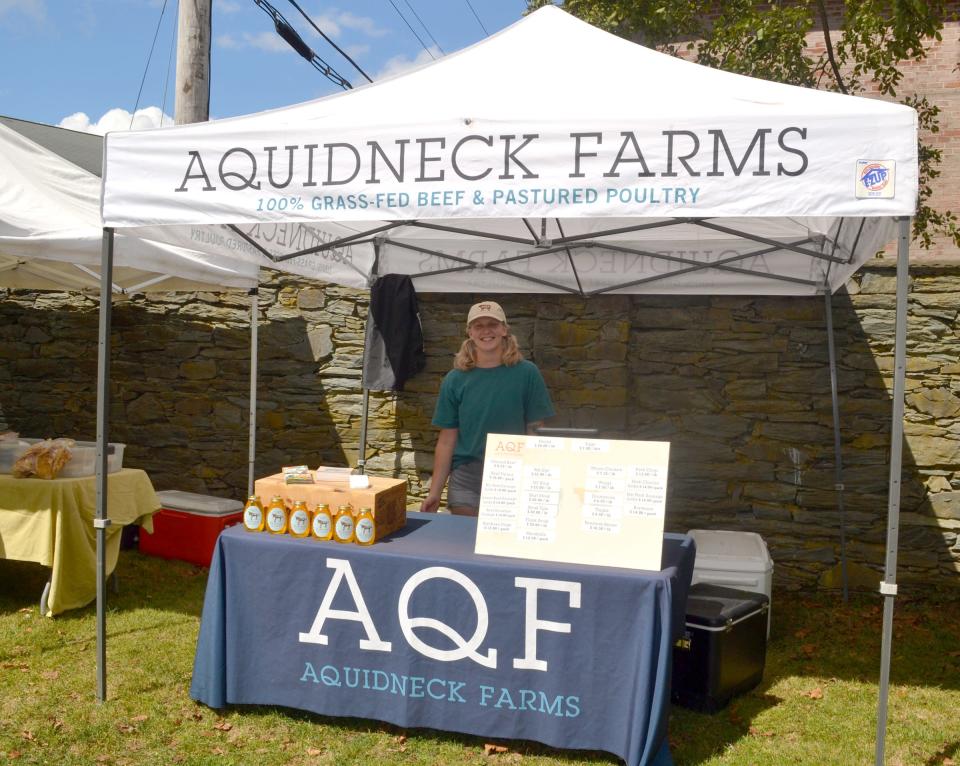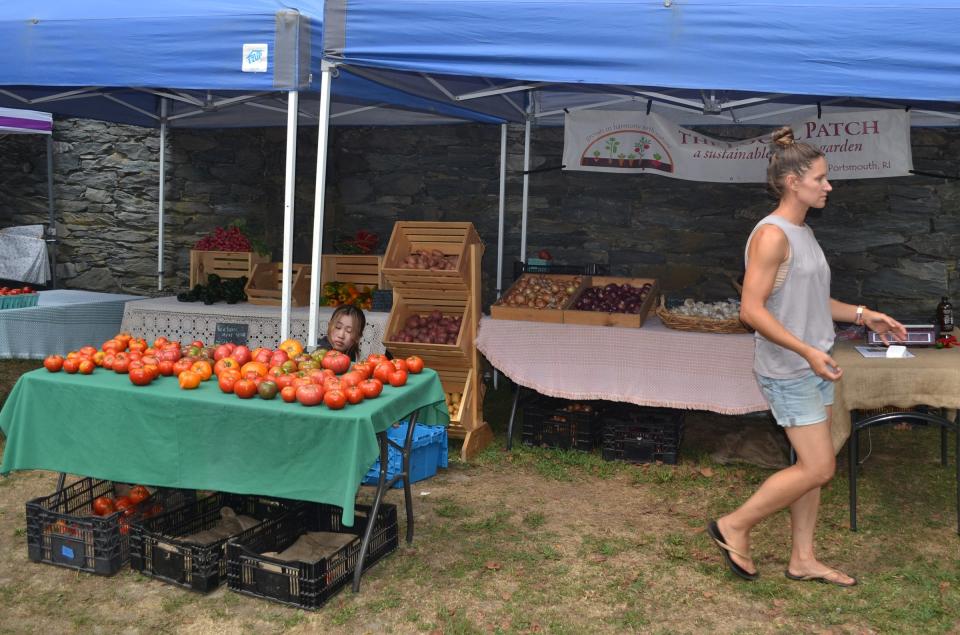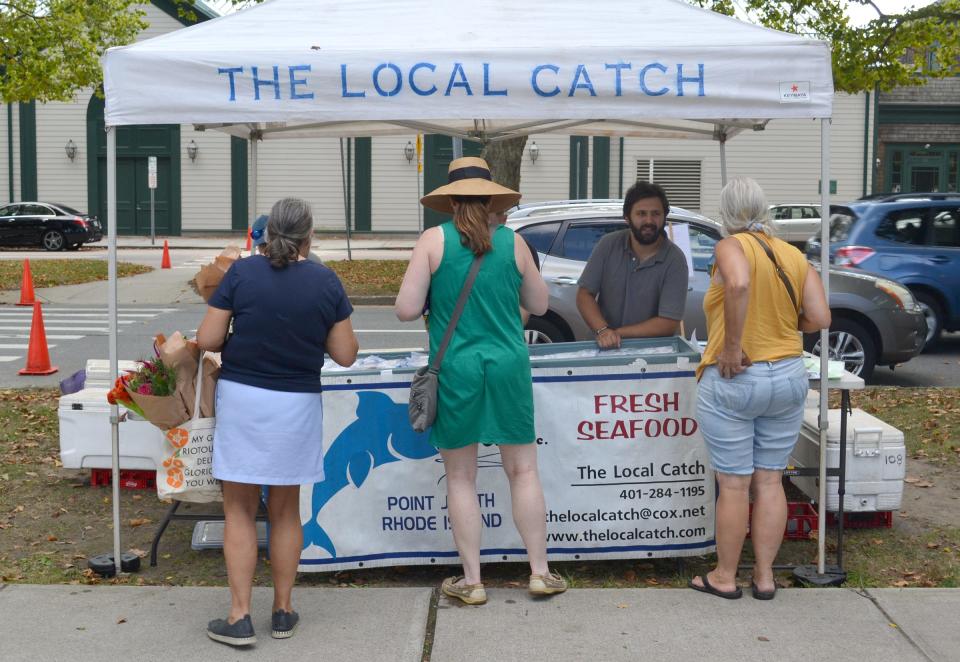'We’re struggling': Onions to clams to Christmas trees, drought has farmers worried
NEWPORT — Aquidneck Farms raises grass-fed beef on 400 acres of pristine farmland in Portsmouth overlooking the Sakonnet River.
The only problem, which anybody with a lawn can relate to after an absolutely scorching July and August, is there is no grass. It’s all been burnt to a crisp.
“It’s hard to feed grass-fed cows when there is nothing growing,” said Emily Watne, sales manager at Portsmouth’s Aquidneck Farms.
Rhode Island has been roasting, and this summer’s drought has hit every farmer in Newport County, whether they raise cattle, carrots or Christmas trees.
“We raise cattle, and our cattle are 100 percent grass-fed," explained Watne, who was running a booth at the Aquidneck Growers Market on Memorial Boulevard on Wednesday. "We also grow hay all summer — that’s how we feed through the winter — and we’re only getting about half as much hay as we normally do.”
“Normally, our cows are able to eat at pasture. They’re just out all summer, but we’ve been having to feed hay because our pastures are not growing back,” she said. “We’ve been feeding hay that we’ve already grown, so we’re going to have less for the winter and we’re already cutting into our supply.”

Watne is a farmer, even when she’s not at work. Her family owns Clark’s Christmas Tree Farm on Main Road in Tiverton, and the tree farm has been hurt by the drought as well. December might seem like a long way off, but she recommends tagging a tree early this year in the expectation of a very limited supply.
Sunny days: Could solar arrays save Portsmouth farms despite stern opposition from residents?
“We’re struggling. You might not think of trees as needing as much water, but we’re losing mature trees,” Watney said. “Everyone will show up the first weekend of December expecting acres and acres of healthy trees, and they just won’t be. They’ll be thin, they’ll be maybe a little bit brown … I would look into places that do tagging, think about it a little bit earlier than usual.”
Emergency loans available for Rhode Island farmers after little rain
According to the National Drought Monitor, all of Rhode Island is in a state of "extreme drought," and although some rain finally fell recently, U.S. Secretary of Agriculture Tom Vilsack on Aug. 22 declared all five Rhode Island counties "primary natural disaster areas" because of the ongoing drought.
According to Sen. Jack Reed’s office, Rhode Island saw less than 0.5 inches of rain this July compared to an average of 2.5 inches.
The federal declaration allows eligible farms to be considered for low-interest, emergency loans and other assistance from the agriculture department's Farm Service Agency. Farmers have eight months from the date of the disaster declaration to apply for assistance.
Drought in R.I.: Check out the latest Drought Monitor maps
“I’m going to look into it — that’s my weekend homework. I hope it’s an easy application process,” said Amy Smith, who owns The Local Patch, a market garden in Portsmouth with a Community Supported Agriculture program.
“I can think of fields I tilled in because it was like, ‘I know I’m not going to be able to irrigate that.’… That was all time spent seeding it, that was all money lost in seeds, in labor, and then I didn’t bring anything to market,” Smith said.

As tangible evidence of the drought’s negative effects, Smith immediately pointed to the onions she was selling.
“Basically the size of our onions — the things just haven’t gotten enough water," Smith said. "So it affects the volume — we’re producing way less of some crops than we could — and also the size of things.”
She also cited some long-term effects of this summer’s drought.
'They're more tasty': The difference in locally grown strawberries and where to pick 'em
“Perennial stuff like our raspberry canes are affected by this year’s drought because it means next year’s crop isn’t getting enough water ... We’d usually just let all that new growth depend on rain, but I can already see that it’s stunted,” Smith said.
Seafood is also being impacted by drought conditions
Dylan Hoy, general manager of seafood distributor The Local Catch, said the area's fishing industry has also been impacted by this summer’s hot conditions. Hoy purchases his clams from various local diggers and has noticed an abnormally high mortality rate in wild shellfish over the past few weeks.

“The clams, the last few weeks, the mortality rate has been through the roof. I’m having them die in the fridge two days after they’re harvested,” he said.
“This summer has been a little bit more extreme I would say … It’s noticeable from my standpoint quality-wise, regarding the mortality rate of shellfish, the stuff that I handle,” comparing the weather to summers past, he said.
Hot potato: Why a Middletown restaurant is warning customers of rising french fry costs
Every vendor at the farmers market who spoke to The Daily News acknowledged their prices were up this summer, but didn’t cite the drought as an immediate factor.
Watne explained the price of chicken feed has gone up sixfold over the past two years, and the farmers mentioned the extremely high price of gas as a factor in price bumps.
“It’s not a catastrophe yet, but we’re watching our wells very closely,” Watne said.
This article originally appeared on Newport Daily News: Drought in Newport County has farmers concerned about variety of crops

